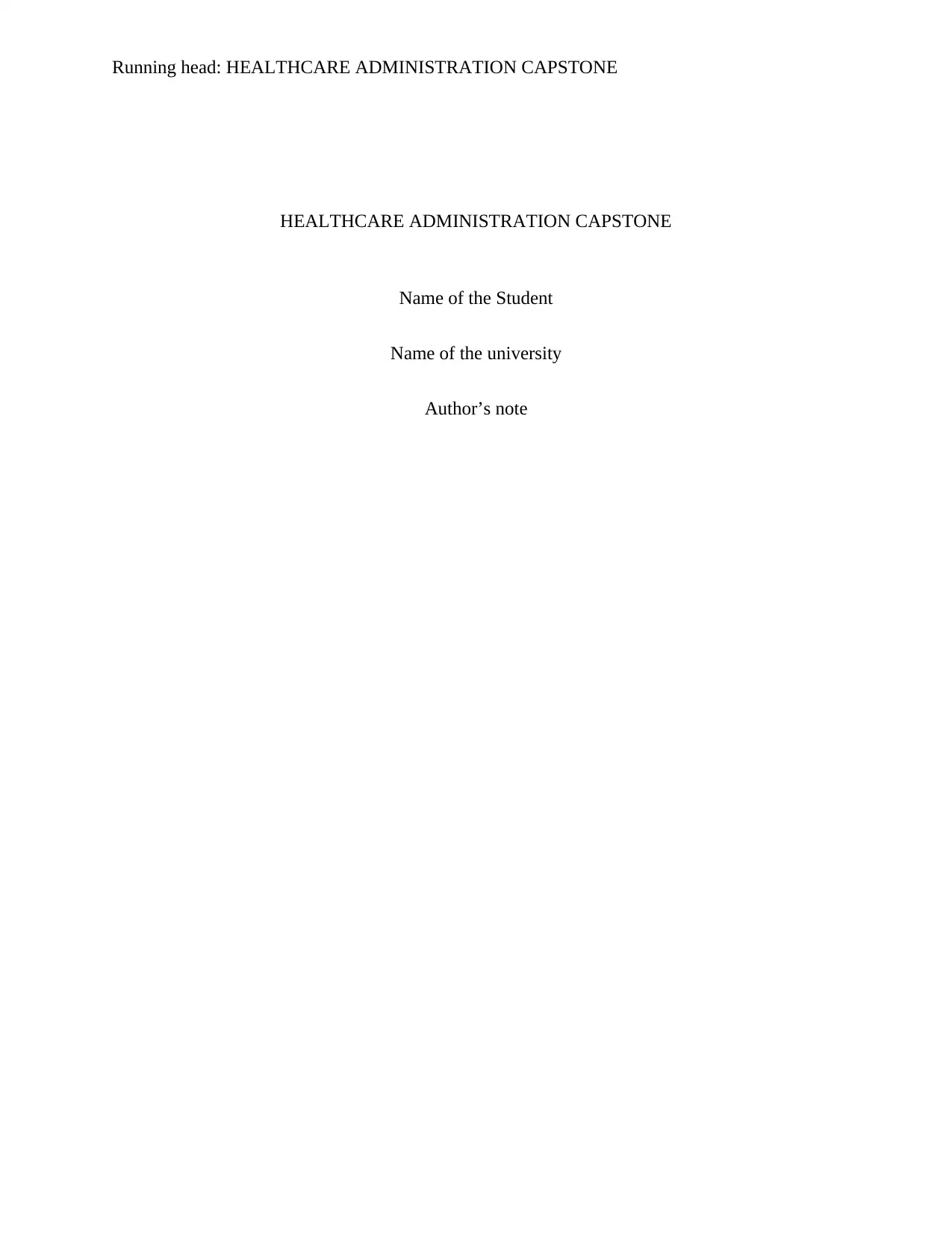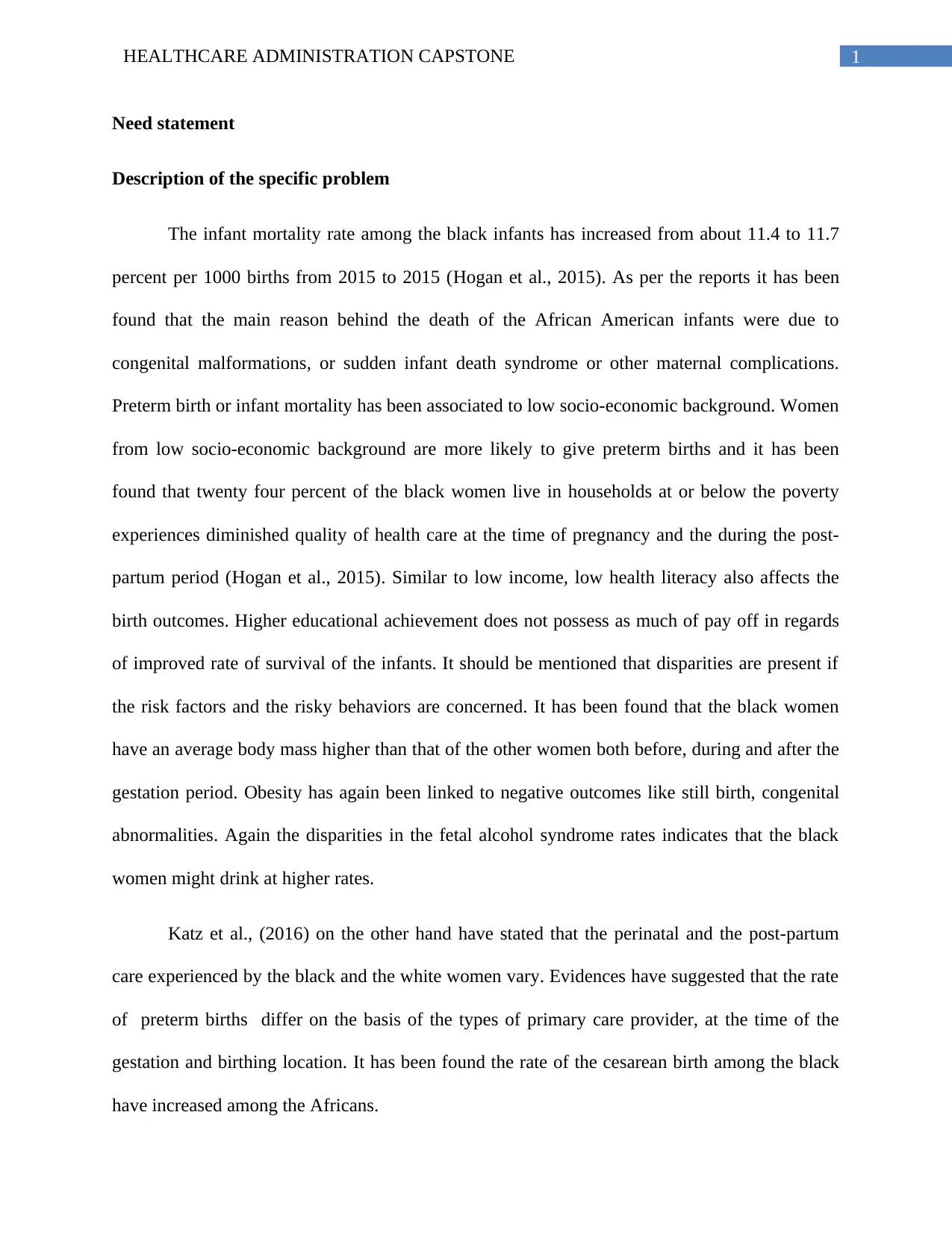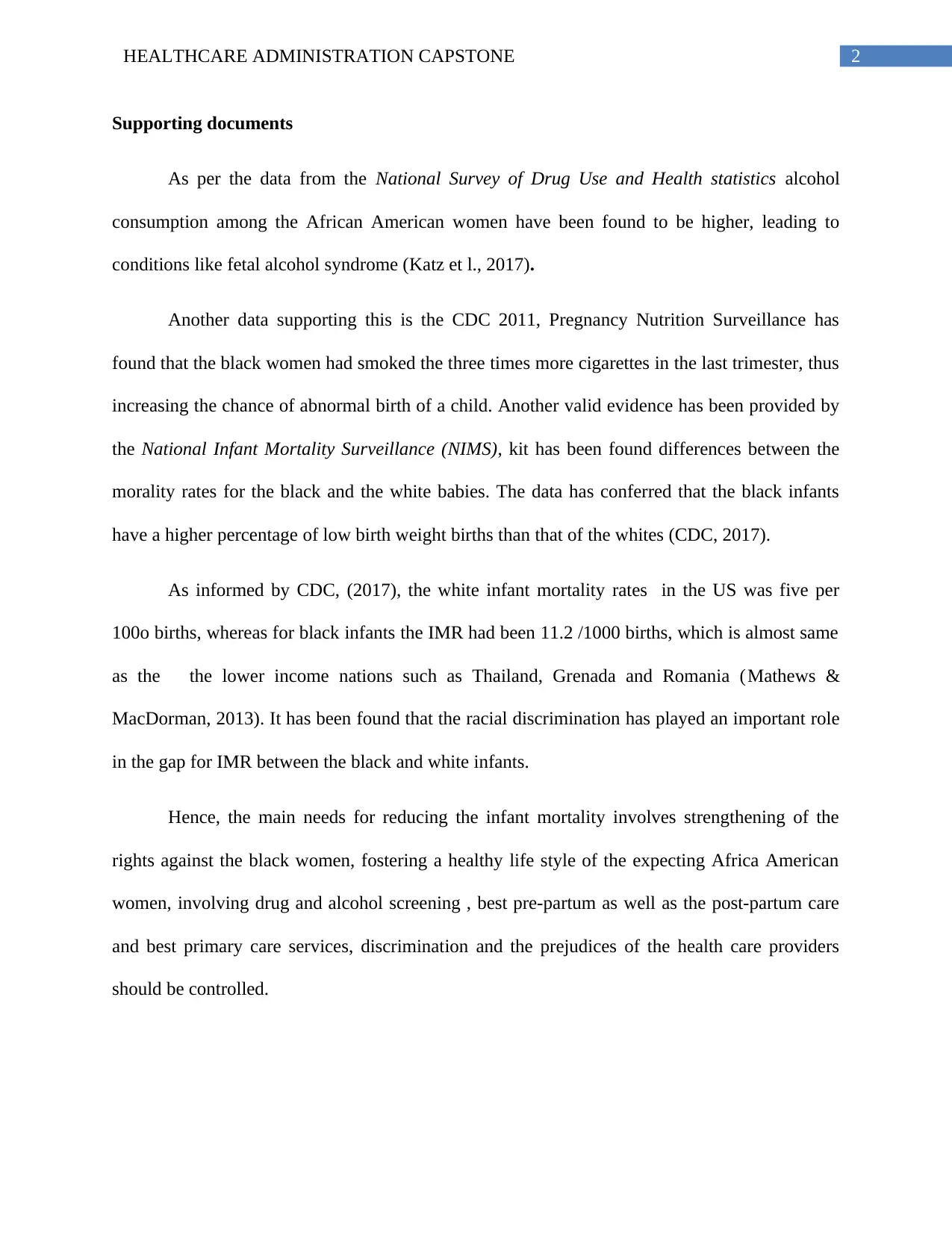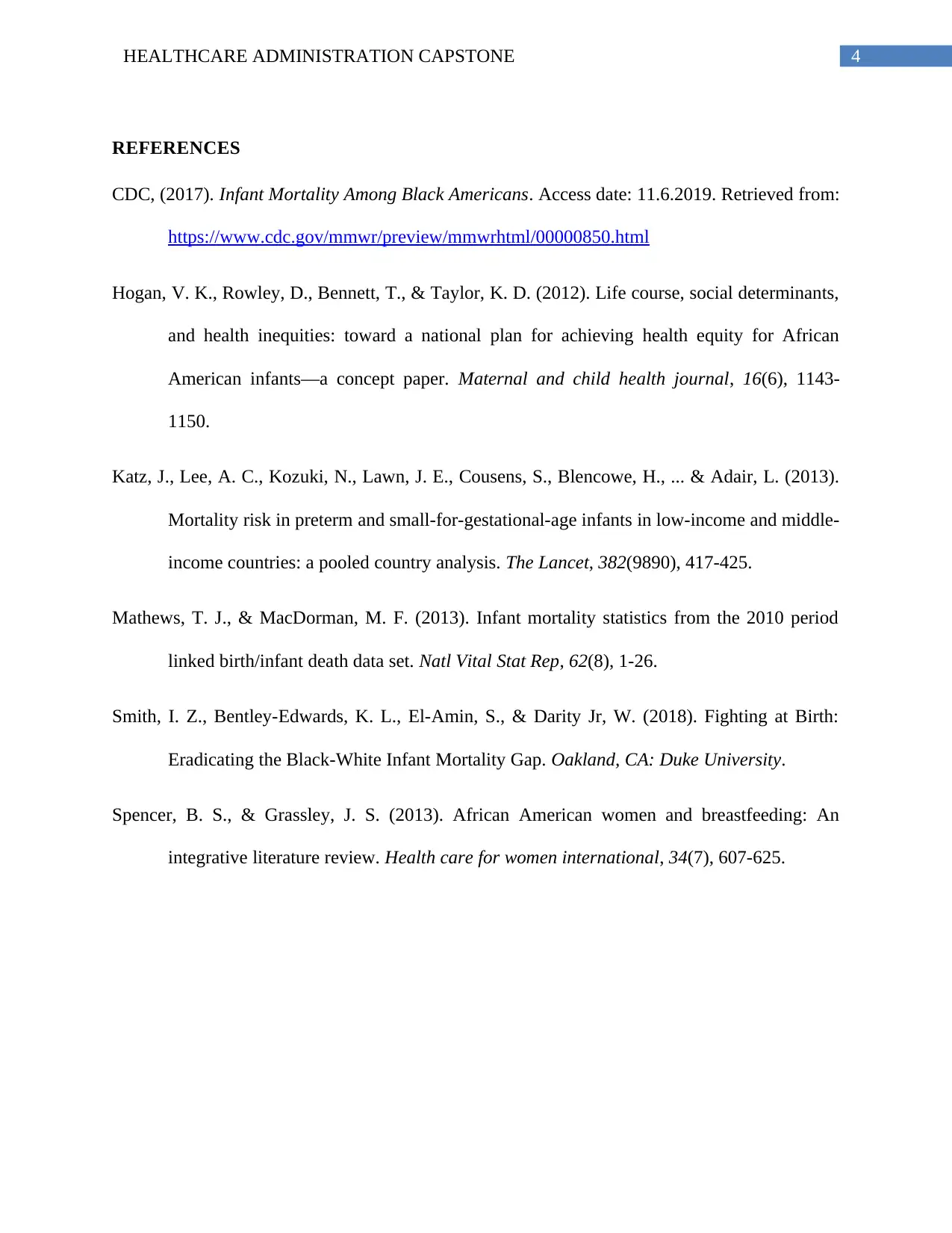Capstone: Addressing Infant Mortality in African American Community
VerifiedAdded on 2023/03/29
|5
|1145
|199
Report
AI Summary
This healthcare administration capstone project addresses the critical issue of infant mortality among African Americans, highlighting the disparity in infant mortality rates compared to other populations. It identifies factors contributing to this disparity, including socioeconomic status, low health literacy, maternal health issues like obesity and substance abuse, and potential biases in healthcare provision. The project emphasizes the need for strengthening the rights of black women, promoting healthy lifestyles, implementing drug and alcohol screening programs, improving prenatal and postpartum care, and addressing discrimination within the healthcare system. It proposes management strategies such as supporting policy programs, regulating treatment protocols, universal screenings for drug abuse, increased social support for expectant mothers, and comprehensive prenatal education programs. The ultimate goal is to reduce the black-white infant mortality gap through improved healthcare access and quality.

Running head: HEALTHCARE ADMINISTRATION CAPSTONE
HEALTHCARE ADMINISTRATION CAPSTONE
Name of the Student
Name of the university
Author’s note
HEALTHCARE ADMINISTRATION CAPSTONE
Name of the Student
Name of the university
Author’s note
Paraphrase This Document
Need a fresh take? Get an instant paraphrase of this document with our AI Paraphraser

1HEALTHCARE ADMINISTRATION CAPSTONE
Need statement
Description of the specific problem
The infant mortality rate among the black infants has increased from about 11.4 to 11.7
percent per 1000 births from 2015 to 2015 (Hogan et al., 2015). As per the reports it has been
found that the main reason behind the death of the African American infants were due to
congenital malformations, or sudden infant death syndrome or other maternal complications.
Preterm birth or infant mortality has been associated to low socio-economic background. Women
from low socio-economic background are more likely to give preterm births and it has been
found that twenty four percent of the black women live in households at or below the poverty
experiences diminished quality of health care at the time of pregnancy and the during the post-
partum period (Hogan et al., 2015). Similar to low income, low health literacy also affects the
birth outcomes. Higher educational achievement does not possess as much of pay off in regards
of improved rate of survival of the infants. It should be mentioned that disparities are present if
the risk factors and the risky behaviors are concerned. It has been found that the black women
have an average body mass higher than that of the other women both before, during and after the
gestation period. Obesity has again been linked to negative outcomes like still birth, congenital
abnormalities. Again the disparities in the fetal alcohol syndrome rates indicates that the black
women might drink at higher rates.
Katz et al., (2016) on the other hand have stated that the perinatal and the post-partum
care experienced by the black and the white women vary. Evidences have suggested that the rate
of preterm births differ on the basis of the types of primary care provider, at the time of the
gestation and birthing location. It has been found the rate of the cesarean birth among the black
have increased among the Africans.
Need statement
Description of the specific problem
The infant mortality rate among the black infants has increased from about 11.4 to 11.7
percent per 1000 births from 2015 to 2015 (Hogan et al., 2015). As per the reports it has been
found that the main reason behind the death of the African American infants were due to
congenital malformations, or sudden infant death syndrome or other maternal complications.
Preterm birth or infant mortality has been associated to low socio-economic background. Women
from low socio-economic background are more likely to give preterm births and it has been
found that twenty four percent of the black women live in households at or below the poverty
experiences diminished quality of health care at the time of pregnancy and the during the post-
partum period (Hogan et al., 2015). Similar to low income, low health literacy also affects the
birth outcomes. Higher educational achievement does not possess as much of pay off in regards
of improved rate of survival of the infants. It should be mentioned that disparities are present if
the risk factors and the risky behaviors are concerned. It has been found that the black women
have an average body mass higher than that of the other women both before, during and after the
gestation period. Obesity has again been linked to negative outcomes like still birth, congenital
abnormalities. Again the disparities in the fetal alcohol syndrome rates indicates that the black
women might drink at higher rates.
Katz et al., (2016) on the other hand have stated that the perinatal and the post-partum
care experienced by the black and the white women vary. Evidences have suggested that the rate
of preterm births differ on the basis of the types of primary care provider, at the time of the
gestation and birthing location. It has been found the rate of the cesarean birth among the black
have increased among the Africans.

2HEALTHCARE ADMINISTRATION CAPSTONE
Supporting documents
As per the data from the National Survey of Drug Use and Health statistics alcohol
consumption among the African American women have been found to be higher, leading to
conditions like fetal alcohol syndrome (Katz et l., 2017).
Another data supporting this is the CDC 2011, Pregnancy Nutrition Surveillance has
found that the black women had smoked the three times more cigarettes in the last trimester, thus
increasing the chance of abnormal birth of a child. Another valid evidence has been provided by
the National Infant Mortality Surveillance (NIMS), kit has been found differences between the
morality rates for the black and the white babies. The data has conferred that the black infants
have a higher percentage of low birth weight births than that of the whites (CDC, 2017).
As informed by CDC, (2017), the white infant mortality rates in the US was five per
100o births, whereas for black infants the IMR had been 11.2 /1000 births, which is almost same
as the the lower income nations such as Thailand, Grenada and Romania (Mathews &
MacDorman, 2013). It has been found that the racial discrimination has played an important role
in the gap for IMR between the black and white infants.
Hence, the main needs for reducing the infant mortality involves strengthening of the
rights against the black women, fostering a healthy life style of the expecting Africa American
women, involving drug and alcohol screening , best pre-partum as well as the post-partum care
and best primary care services, discrimination and the prejudices of the health care providers
should be controlled.
Supporting documents
As per the data from the National Survey of Drug Use and Health statistics alcohol
consumption among the African American women have been found to be higher, leading to
conditions like fetal alcohol syndrome (Katz et l., 2017).
Another data supporting this is the CDC 2011, Pregnancy Nutrition Surveillance has
found that the black women had smoked the three times more cigarettes in the last trimester, thus
increasing the chance of abnormal birth of a child. Another valid evidence has been provided by
the National Infant Mortality Surveillance (NIMS), kit has been found differences between the
morality rates for the black and the white babies. The data has conferred that the black infants
have a higher percentage of low birth weight births than that of the whites (CDC, 2017).
As informed by CDC, (2017), the white infant mortality rates in the US was five per
100o births, whereas for black infants the IMR had been 11.2 /1000 births, which is almost same
as the the lower income nations such as Thailand, Grenada and Romania (Mathews &
MacDorman, 2013). It has been found that the racial discrimination has played an important role
in the gap for IMR between the black and white infants.
Hence, the main needs for reducing the infant mortality involves strengthening of the
rights against the black women, fostering a healthy life style of the expecting Africa American
women, involving drug and alcohol screening , best pre-partum as well as the post-partum care
and best primary care services, discrimination and the prejudices of the health care providers
should be controlled.
⊘ This is a preview!⊘
Do you want full access?
Subscribe today to unlock all pages.

Trusted by 1+ million students worldwide

3HEALTHCARE ADMINISTRATION CAPSTONE
SPECIFIC MANAGEMENT THEORIES
On the basis of the needs assessments, some recommendations can be provided such as
the there has to be ample support for the policy programs and the advocacy groups, catering to
the perinatal and the post-partum requirements of the black women. Again policies needs to be
implemented that would regulate the treatment protocol for minimizing the biases of the
providers. Efforts should be given at mitigating the black-white American discrepancy via
universal screenings for drug abuse and providing referrals to the treatment groups (Smith et al.,
2016). Laws should be enforced to protect the black women against any kind of discrimination.
The social support has to be increased for the expectant black women. Further managements
approaches that are required comprehensive prenatal education programs. Again, cost saving
initiatives enabling the providers for promoting normal vaginal birth practice and consultation
about breastfeeding (Spencer & Grassley, 2013). As per the needs assessment, the infant and the
maternity care should be improved, especially for the Black African American. Again,
collaborative policies are required between the birthing centers and the hospitals.
SPECIFIC MANAGEMENT THEORIES
On the basis of the needs assessments, some recommendations can be provided such as
the there has to be ample support for the policy programs and the advocacy groups, catering to
the perinatal and the post-partum requirements of the black women. Again policies needs to be
implemented that would regulate the treatment protocol for minimizing the biases of the
providers. Efforts should be given at mitigating the black-white American discrepancy via
universal screenings for drug abuse and providing referrals to the treatment groups (Smith et al.,
2016). Laws should be enforced to protect the black women against any kind of discrimination.
The social support has to be increased for the expectant black women. Further managements
approaches that are required comprehensive prenatal education programs. Again, cost saving
initiatives enabling the providers for promoting normal vaginal birth practice and consultation
about breastfeeding (Spencer & Grassley, 2013). As per the needs assessment, the infant and the
maternity care should be improved, especially for the Black African American. Again,
collaborative policies are required between the birthing centers and the hospitals.
Paraphrase This Document
Need a fresh take? Get an instant paraphrase of this document with our AI Paraphraser

4HEALTHCARE ADMINISTRATION CAPSTONE
REFERENCES
CDC, (2017). Infant Mortality Among Black Americans. Access date: 11.6.2019. Retrieved from:
https://www.cdc.gov/mmwr/preview/mmwrhtml/00000850.html
Hogan, V. K., Rowley, D., Bennett, T., & Taylor, K. D. (2012). Life course, social determinants,
and health inequities: toward a national plan for achieving health equity for African
American infants—a concept paper. Maternal and child health journal, 16(6), 1143-
1150.
Katz, J., Lee, A. C., Kozuki, N., Lawn, J. E., Cousens, S., Blencowe, H., ... & Adair, L. (2013).
Mortality risk in preterm and small-for-gestational-age infants in low-income and middle-
income countries: a pooled country analysis. The Lancet, 382(9890), 417-425.
Mathews, T. J., & MacDorman, M. F. (2013). Infant mortality statistics from the 2010 period
linked birth/infant death data set. Natl Vital Stat Rep, 62(8), 1-26.
Smith, I. Z., Bentley-Edwards, K. L., El-Amin, S., & Darity Jr, W. (2018). Fighting at Birth:
Eradicating the Black-White Infant Mortality Gap. Oakland, CA: Duke University.
Spencer, B. S., & Grassley, J. S. (2013). African American women and breastfeeding: An
integrative literature review. Health care for women international, 34(7), 607-625.
REFERENCES
CDC, (2017). Infant Mortality Among Black Americans. Access date: 11.6.2019. Retrieved from:
https://www.cdc.gov/mmwr/preview/mmwrhtml/00000850.html
Hogan, V. K., Rowley, D., Bennett, T., & Taylor, K. D. (2012). Life course, social determinants,
and health inequities: toward a national plan for achieving health equity for African
American infants—a concept paper. Maternal and child health journal, 16(6), 1143-
1150.
Katz, J., Lee, A. C., Kozuki, N., Lawn, J. E., Cousens, S., Blencowe, H., ... & Adair, L. (2013).
Mortality risk in preterm and small-for-gestational-age infants in low-income and middle-
income countries: a pooled country analysis. The Lancet, 382(9890), 417-425.
Mathews, T. J., & MacDorman, M. F. (2013). Infant mortality statistics from the 2010 period
linked birth/infant death data set. Natl Vital Stat Rep, 62(8), 1-26.
Smith, I. Z., Bentley-Edwards, K. L., El-Amin, S., & Darity Jr, W. (2018). Fighting at Birth:
Eradicating the Black-White Infant Mortality Gap. Oakland, CA: Duke University.
Spencer, B. S., & Grassley, J. S. (2013). African American women and breastfeeding: An
integrative literature review. Health care for women international, 34(7), 607-625.
1 out of 5
Related Documents
Your All-in-One AI-Powered Toolkit for Academic Success.
+13062052269
info@desklib.com
Available 24*7 on WhatsApp / Email
![[object Object]](/_next/static/media/star-bottom.7253800d.svg)
Unlock your academic potential
Copyright © 2020–2025 A2Z Services. All Rights Reserved. Developed and managed by ZUCOL.



